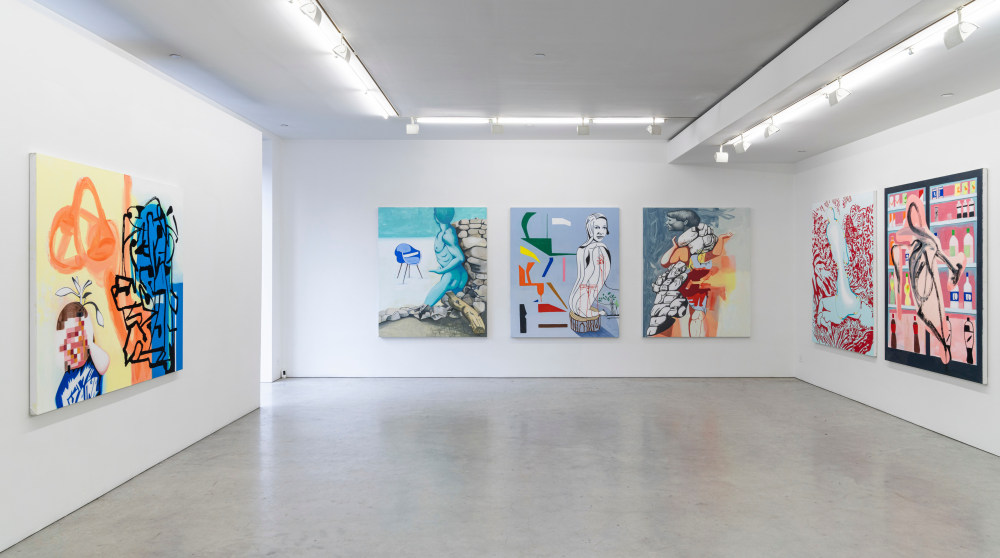
Contributed by Jonathan Stevenson / The phenomenon of the selfie, an artifact of the smart phone, is a supreme irony. The act itself suggests a narcissistic preoccupation with recording one’s presence, but its frequency and ubiquity indicates that it doesn’t matter much what person or place gets that honor. Warhol’s fleeting fifteen minutes is compressed into a pandering fraction of a second. I was here; please care. The only auto-photographers who really seem to get durably noticed are the Darwin Award winners whose acrobatic exertions towards drama topple them into the lethal maw of treacherous vistas. Lost in the scree of evanescent look-at-me images is the self in full social and political context, and it’s not in plain sight. There are few painters better suited for excavating it than David Humphrey, as he demonstrates in “porTraits,” his formidable solo exhibition now up at Fredericks & Freiser. Humphrey’s crowning gift – born of comprehensive technical and aesthetic command, a uniquely graphic allusive approach, sardonic wit, and an irrepressible narrative impulse – is to coordinate the nuances of disparate visual elements so finely as to render the busiest of paintings piercingly, disturbingly coherent.
All ten large acrylic paintings – jarring in their fusion of pristine line, unyielding matte color, and weird content – are eerie enough to get under your skin. The topper may be Abandoned Rooms. A placid everyman, notionally the artist, stands in a room at once heated and air-conditioned, graffitied with an SOS plea and other more equivocal characters, a Guston-inflected and abstractly erotic blob hovering above his head, trying to point at ideas scrawled half-intelligibly but deprived of an index finger and haunted by a maternal apparition. It’s a dauntingly loaded and variegated picture, yet the net impact is singular and forceful: this bemused soul can’t manage everything he feels and perceives. The painting stands as a paradoxically grand testament to the artist’s humility. Imparting a similar idea more directly is Plant Thoughts. Here the mind-body problem seems to overwhelm the subject to the point of self-negation, while the pixelation of their face suggests the vexations of the surveillance state and the compulsion to obscure oneself despite the countervailing obsession with self-documentation. That’s a lot, and psychic and philosophical overload is an important theme for Humphrey, often in juxtaposition with apparent physical order. In Luggage, the owner of neatly arranged suitcases falls apart, spilling out of an airport bathroom or customs office. The painting conveys the difficulty technology has in capturing the essence of human beings as distinct from inanimate objects. The consumer in Colored Drinks, though they are neatly arrayed, is so spoiled for choice that he wants to smash the bottles, constrained by a video camera or maybe not. Designer has the eponymous figure torn between demonstrating and prescribing fashion, on a pedestal or a chopping block.
Humphrey’s starting premise may be, as the press statement suggests, that all artworks are, “in some way, self-portraits.” That’s a provocative catchphrase, but plumbing its significance requires reveling in the details. The other five big paintings, less replete though hardly sparse, are equally rich in the subtleties that etch metaphors or messages. Here they seem fundamentally about the inexorable and trans-generational reciprocity between self and environment. Humphrey can seamlessly layer different evolutionary eras into single pictures,. In Wolf, a lurking man appears to have stabbed the traditional predator, whose paws and torso are suspiciously anthropomorphic, in the back. The presumptively prehistoric man in Before the Chair still had infrastructure for sitting, and the grotesquely hybrid fellow in Rock Man declares that the contemporary version is far from fully evolved. Humphrey takes a droll step back to ponder such insights. A couple in Café in Athens joins other folk to behold art, then has coffee or a drink to talk about it, as tacitly required. In Hiker, the titled itinerant has interrupted a couple having sex in the woods – or maybe it is they who have disrupted his Thoreauvian idyl. If Alice Neel’s currency as a portraitist was sobering isolation, Humphrey’s is discomfiting connectedness.
In the backroom of the gallery, Jennifer Coates – a noted painter and Humphrey’s wife – has cleverly curated discrete sets, wall by wall, of loosely associated small paintings, drawings, and sculptures, one including a video. While the ten featured paintings crystallize Humphrey’s current thinking, the backroom suggests how his work emerges in response to external stimuli and recursively informs what comes next – from self to canvas, as it were, and back again through the ambient noise. That’s explicitly the way he rolls and, you could argue, the way most artists implicitly do. Over his previous four exhibitions, Humphrey cut a true and fascinating swath through an increasingly distressed zeitgeist, his figures moving from comfortable to encroached upon to threatened to cowed, blinkered, even solipsistic. With his deeply considered new work, arguably his most complex, he might be saying we have only ourselves to blame.